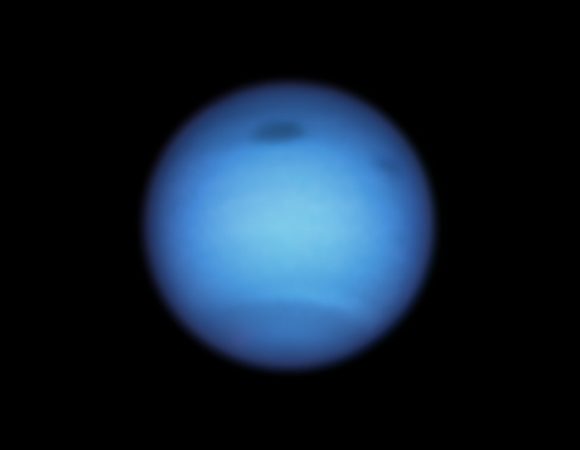In 2018, astronomers using the NASA/ESA Hubble Space Telescope spotted a giant dark storm, which is 7,400 km (4,600 miles) across, in the northern hemisphere of Neptune. Observations a year later showed that the vortex began drifting southward toward the equator, where such storms are expected to vanish from sight. To the surprise of astronomers, Hubble spotted the vortex change direction by August 2020, doubling back to the north. At the same time as the spot’s stunning reversal, a new, slightly smaller dark feature appeared near its bigger cousin and later disappeared.
Source: Sci News
Neptune’s dark vortices are high-pressure systems that can form at mid-latitudes and may then migrate toward the equator.
They start out remaining stable due to Coriolis forces, which cause northern hemisphere storms to rotate clockwise, due to the planet’s rotation. However, as a storm drifts toward the equator, the Coriolis effect weakens and the storm disintegrates.
In computer simulations, these storms follow a more-or-less straight path to the equator, until there is no Coriolis effect to hold them together.
Unlike the simulations, the recently-spotted giant storm didn’t migrate into the equatorial ‘kill zone.’
“It was really exciting to see this one act like it’s supposed to act and then all of a sudden it just stops and swings back. That was surprising,” said Dr. Michael H. Wong, an astronomer at the University of California at Berkeley.
The Hubble observations also revealed that the dark vortex’s puzzling path reversal occurred at the same time that a new spot appeared.
The newest spot was slightly smaller than its cousin, measuring about 6,300 km (3,900 miles) across.
It was near the side of the main dark spot that faces the equator — the location that some simulations show a disruption would occur.
However, the timing of the smaller spot’s emergence was unusual.
“When I first saw the small spot, I thought the bigger one was being disrupted,” Dr. Wong said.
“I didn’t think another vortex was forming because the small one is farther towards the equator. So it’s within this unstable region. But we can’t prove the two are related. It remains a complete mystery.”
“It was also in January that the dark vortex stopped its motion and started moving northward again, he added.
“Maybe by shedding that fragment, that was enough to stop it from moving towards the equator.”
“We wouldn’t know anything about these latest dark spots if it wasn’t for Hubble,” said Dr. Amy Simon, an astronomer at NASA’s Goddard Space Flight Center.
“We can now follow the large storm for years and watch its complete life cycle.”
“If we didn’t have Hubble, then we might think the Great Dark Spot seen by Voyager in 1989 is still there on Neptune, just like Jupiter’s Great Red Spot. And, we wouldn’t have known about the four other spots Hubble discovered.”
The astronomers presented their results this week at the fall meeting of the American Geophysical Union.
Source: Sci News

































Leave a Comment
You must be logged in to post a comment.